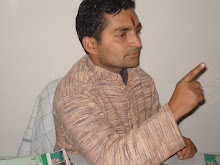POLITICS-NEPAL: Now Ethnic Separatism
POLITICS-NEPAL: Now Ethnic Separatism
August 21st, 2006
Suman Pradhan-
KATHMANDU, Aug 21 (IPS) - A splinter Maoist faction in Nepal’s southern Terai plains is calling for full sovereignty and independence in what is turning to be the first separatist movement in the country’s history.
The Terai Jantantrik Liberation Front (TJLF), led by former Maoist Jayakrishna Goit, has been battling Maoists since 2004 for control of the Terai agenda. But, to the dismay of many, his group has recently been hounding settlers from the hills, locally known as ‘Pahadiyas’, in a bid to drive them out of the Terai.
An impoverished, landlocked country facing a violent Maoist insurgency since 1996, Nepal can ill afford a separatist movement just when it is seeking to resolve the Maoist conflict. But ignorance of Terai grievances, where 48 percent the country’s 26 million people live, is fanning the flames of radicalism and separatism. Goit’s slogan that the Terai, known as Madhes, is only for the Madhesis is igniting fears of a separatist war and deepening the hills-plains divide in this country. Madhesis are people of Indian origin who have settled in the Terai for decades. Most are Nepali citizens but a huge number lack citizenship.
The separatism is being fuelled by two distinct factors: Goit’s fight with the Maoists, and the age-old discrimination felt by the Madhesi community at large. Last week, Goit gave voice to those feelings when he told a group of journalists, “We are fighting for independence because we have been discriminated against for too long.”
Goit’s separatist activities so far have been confined to only a handful of Terai districts, mostly in areas from Saptari to Rautahat in the east-central Terai.
Spanning Nepal’s entire south from east to west, the Terai is Nepal’s industrial and agricultural bread basket. For long dormant, as exclusion and inequalities within the hill community gained top priority in the national agenda, Terai grievances suddenly flared up in June when TJLF fighters kidnapped for ransom several Pahadiya government officers and forcibly closed down a few industries owned by Pahadiya settlers in Saptari district.
A July 2006 U.N. report by the Office of the Coordinator of Humanitarian Affairs, states: “The situation was rather volatile in Terai districts, especially in early June. The Janatantrik Terai Liberation Front (sic), a Maoist break away, issued threats against the hill ethnic groups settled in the Terai, asking them to go back to their villages.”
While Nepal remains focused on the difficulties surrounding delicate negotiations between the government and Maoist rebels, the Terai districts are on the brink of an upheaval. The issues encompass not only Maoist in-fighting but identity politics and a sense of discrimination felt by the Madhesis.
The trend is worrying Terai intellectuals and activists who oppose the dismemberment of Nepal. They argue that Nepal should remain united, and its leaders must address discrimination lest separatist tendencies grow.
“There is no support in the Madhesi community for an independent Madhes. We all want to be part of Nepal,” asserts Vijay Kant Karna, a Madhesi lecturer of political science and chairman of Jaghrit Nepal, a Madheshi-upliftment group. “But I cannot say what will happen in the future if Madhesis do not get due recognition in the state restructuring that is being talked about.”
“We Madhesis are looked down upon. Our language and culture are not respected. We are not represented adequately in the civil administration and other state institutions. These must stop or the fire will only grow,” says Jayaprakash Gupta, a Madhesi former government minister who is now general secretary of the Madhesi Janadhikar Forum (MJF).
A lifelong communist, Goit was lured into the Maoist fold by top Madhesi Maoist leader Matrika Prasad Yadav. Appointed the first chairman of the Maoists’ Terai Liberation Front, Goit split the Front in late 2004 and formed the TJLF after Yadav replaced him as chairman. The TJLF has an estimated 150-200 fighters.
People who have known Goit for years say the TJLF leader took up his radical agenda after falling out with the Maoists over three major issues - his replacement by Yadav in the Maoists’ Terai Liberation Front, anti-Madhesi discrimination even within the Maoist hierarchy, and the Maoists’ division of Madhes into two separate regions - the Madhes autonomous region which spans east to west-central Nepal, and Tharuwan autonomous region which encompasses western Terai.
“Goit was dissatisfied by the discrimination practiced by the Maoists within their own ranks. Very few Madhesis got leadership roles in the party’s organizational structure in Madhes. Almost all were sent from the hills,” says Karna.
“There was plenty of discrimination which resulted in dissatisfaction,” agrees Maoist leader Yadav. But now, Yadav asserts, these issues have largely been addressed.
But whatever rectification measures the Maoists implanted, Goit remained unsatisfied. Having lost his leadership position, and disagreeing vehemently with the Maoists’ division of Madhes, he split and formed the TJLF.
“Nepal’s ruling elites have forever been suspicious of Madhes because they think these people are of Indian origin, and therefore pro-Indian,” says MJF leader Gupta “That is not true. We Madhesis are as much Nepali and pro-Nepal as anyone else. But I am not surprised that Goit is seeing this division of Madhes by the Maoists as an attempt by the Pahadiyas to diffuse Madhes’ power. I too think that is the case.”
Even Maoist leader Yadav struggles to accept this division. “I am in favour of a unified Madhes,” he says. “But I also believe there can be separate regions within a unified Madhes. (END/2006)
Source::http://www.ipsnews.net/news.asp?idnews=34406


0 Comments:
Post a Comment
<< Home